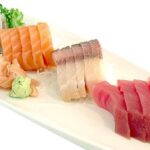Sushi is a Japanese artistic delicacy that consists of fish, vegetables, rice, and seaweed. At first glance, this mixture of ingredients appears wholesome and nutritious, but different preparation methods and ingredients can drastically alter the nutritional value of sushi rolls.
Sushi rolls are healthy when consumed in moderation. They combine raw fish, vinegared rice, and seaweed, which are nutritious and low-calorie. However, some variations contain unhealthy ingredients, like fried fish, and eating sushi every day isn’t recommended since it can lead to mercury poisoning.
To learn more about the nutritional benefits of sushi and some potential health risks to consider, read on.
The Health Benefits of Sushi
These are the health benefits of eating sushi.
Fish Intake Can Increase Heart Health
The American Heart Association recommends that people eat two servings of fish twice a week. Salmon, in particular, is high in protein and omega-3 fatty acids, which can reduce the risk of heart disease. DHA is a compound found in oily fish like herring, tuna, and mackerel, and can lower blood pressure, leading to improved heart health.
Fermentation Enhances Gut Health
When sushi was first invented, it consisted mainly of fermented ingredients. In fact, the word “sushi” roughly translates to “sour.” Fermented foods are still a staple in Japanese cuisine and are considered a contributing factor to the population’s health. These foods can improve the gut’s microbiome, which plays an essential role in human health.
Natural Ingredients Boost the Immune System
As mentioned earlier, fish is full of omega-3 fatty acids and many species are also high in selenium which may have anti-cancer properties. However, fish isn’t the only ingredient in sushi that has health benefits.
- Seaweed – Known as “nori” in Japan, seaweed is often used to wrap sushi rolls and is high in iodine and antioxidants. Iodine is a necessary element that our bodies use to maintain our endocrine system. The right balance allows for optimal metabolic functioning. Antioxidants play a role in the prevention of disease by protecting cells.
- Ginger – This root is used in between eating servings of sushi to cleanse the palette. Some sushi chefs incorporate ginger directly into the sushi as they make it. Ginger has powerful healing properties and has been used in herbal medicine for centuries. It reduces inflammation, calms gastrointestinal symptoms, improves circulation, and inhibits the growth of certain bacteria.
- Wasabi – Wasabi is Japanese horseradish. This sauce is sharp, pungent, and spicy. It’s used to add savory flavors to sushi. It has antimicrobial properties and is known to kill certain forms of E. coli and Staphylococcus bacteria.
Sushi Contains Concentrated Vitamins and Minerals
Sushi has numerous vitamins and minerals like beta-carotene, A and B vitamins, selenium, iodine, and protein. The seaweed used in sushi contains ten times more vitamins than other leafy greens like spinach, and has negligible sugar content.
The Health Risks of Eating Sushi
Considering the many health benefits and natural ingredients, you might be wondering, “are sushi rolls healthy?” If they are healthy, does that mean you can eat them every day? Although sushi is an excellent source of vitamins and minerals, there are some health risks associated with consuming it, both occasionally and regularly, usually due to the raw fish.
Raw and Undercooked Fish Can Harbor Parasites
Raw and undercooked fish increase the risk of foodborne illness and parasites that can cause infections in humans. The Anisakis worm, also known as the herring worm, is a nematode around .78 inches (2 centimeters) long and is found in raw and undercooked fish. These parasites are found in many different species of fish and squid.
When infected fish are consumed, the live parasite enters the human body where it can cause nausea, vomiting, and diarrhea. This disease, known as anisakiasis, usually has short-lived symptoms. It’s rarely diagnosed as it mimics common food poisoning.
Preventing parasites is as simple as cooking or freezing fish. The FDA recommends cooking fish to a temperature of at least 133°F (56°C) for five minutes. For sushi-grade fish, flash-freezing for 15 hours at -31°F (-35°C) is recommended. Regular freezing to a temperature of -4°F (-20°C) for a week is also effective.
Sushi Contains Higher Levels of Mercury
Researchers from Rutgers University concluded that there are high levels of mercury in sushi. Individuals who eat sushi daily tend to have high blood-mercury levels. Tuna sashimi had the highest levels of mercury in the samples tested. Individuals who consume this variation of sushi regularly may be susceptible to mercury poisoning.
No method will reduce mercury levels in fish, including cooking. All fish, however, should be adequately cleaned and gutted as mercury is often found in the organs of fish. These parts of the fish should not be eaten. There are charts available for determining which fish have the highest mercury levels, so you know which to avoid when eating sushi.
Some Recipes Incorporate Unhealthy Ingredients
Simple sushi in Japan consists of thin, raw slices of fish. These pieces are eaten on rice, usually seasoned with vinegar. This basic sushi is healthy when eaten in moderation. However, some sushi on the market is not nutritious and can be bad for you.
As sushi’s popularity has spread, its localized variations have transformed too. Some fusion recipes contain fatty, high-calorie ingredients like mayonnaise, fried shrimp, and fried onions. These concoctions are not as healthy as the simpler, authentic Japanese sushi and are high in saturated and trans fat.
Can I Eat Sushi Every Day?
Eating fish twice a week is recommended by the American Heart Association, although this typically refers to cooked fish. However, enjoying raw fish twice a week is unlikely to cause any significant health issues. Eating sushi every day is not recommended because of the potential for mercury poisoning.
If you have a craving for sushi that can’t be curbed, consider enjoying fish-free sushi such as maki. Maki is grilled seaweed, rice, and various other fillings. We’ll discuss two fish-free sushi options in the next section.
Best Types of Sushi To Eat For Your Health
The Japanese diet is believed to contribute significantly to the population’s longer lifespans, with fish as a prominent staple. Fish is high in EPA and DHA fatty acids, which are great for heart health. When eating sushi, there are certain types that are better for you, including:
- Nigiri – Thin slices of raw fish topped with small balls of rice with vinegar
- Sashimi – Thin slices of raw fish (no rice is included in sashimi, and it’s not technically considered sushi)
- Natto – Fermented soybean sushi, often served with mustard and soy sauce
- Maki – Grilled seaweed, vinegared rice, and other ingredients like vegetables
Experimenting with different flavors of sushi allows you to enjoy a more balanced diet with various vitamins and minerals. In addition to regular sushi with rice, fish, and nori, there are vegan alternatives such as cucumber rainbow sushi, or sushi made with tofu, or tempeh.
Additionally, you can switch to sushi rolls that use salmon and mackerel, which are low in mercury. Wasabi and pickled ginger (gari) are recommended over soy sauce, as they have lower sodium levels.
Conclusion
Sushi is a nutritious addition to any healthy diet when eaten in moderation. It boosts the immune system, improves heart health, enhances the gut biome, and provides numerous vitamins and minerals for your overall wellbeing.
There are, however, some health risks associated with eating raw or undercooked fish. The key is to be mindful of the species of fish you’re consuming. Lastly, avoid sushi variations that contain fried or fatty ingredients, and always consult a doctor if you experience symptoms after eating sushi.
Sources
- FDA: FDA Announces New Qualified Health Claims for EPA and DHA Omega-3 Consumption and The Risk of Hypertension and Coronary Heart Disease
- Harvard School of Public Health: The Microbiome
- US National Library of Medicine: Selenium Anticancer Properties and Impact on Cellular Redox Status
- US National Library of Medicine: Antibacterial Activities of Wasabi Against E. Coli
- University of Washington: Sushi Parasites Have Increased 283-Fold in the Past 40 Years
- CDC: Anisakiasis – Frequently Asked Questions
- Tufts University: What Are The Pros and Cons of Eating Raw Fish, As In Sushi?
- Journal of Risk Research: Sushi Consumption Rates and Mercury Levels in Sushi – Ethnic and Demographic Differences in Exposure
- National Resources Defense Council: The Smart Seafood Buying Guide
- Harvard School of Public Health: The Mercury Question – How To Understand Risk vs Reward When Eating Fish
- NBC News: Is It Safe To Eat Sushi?



